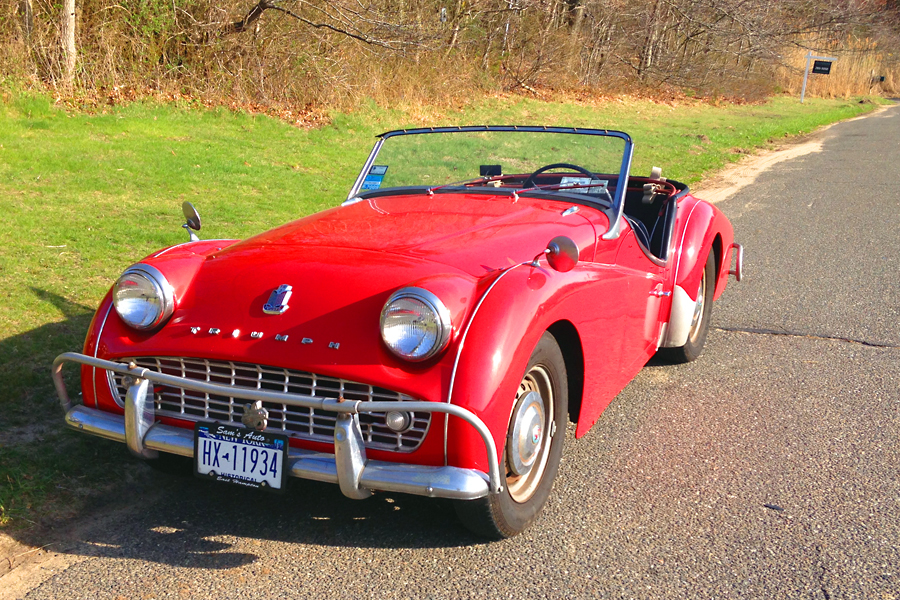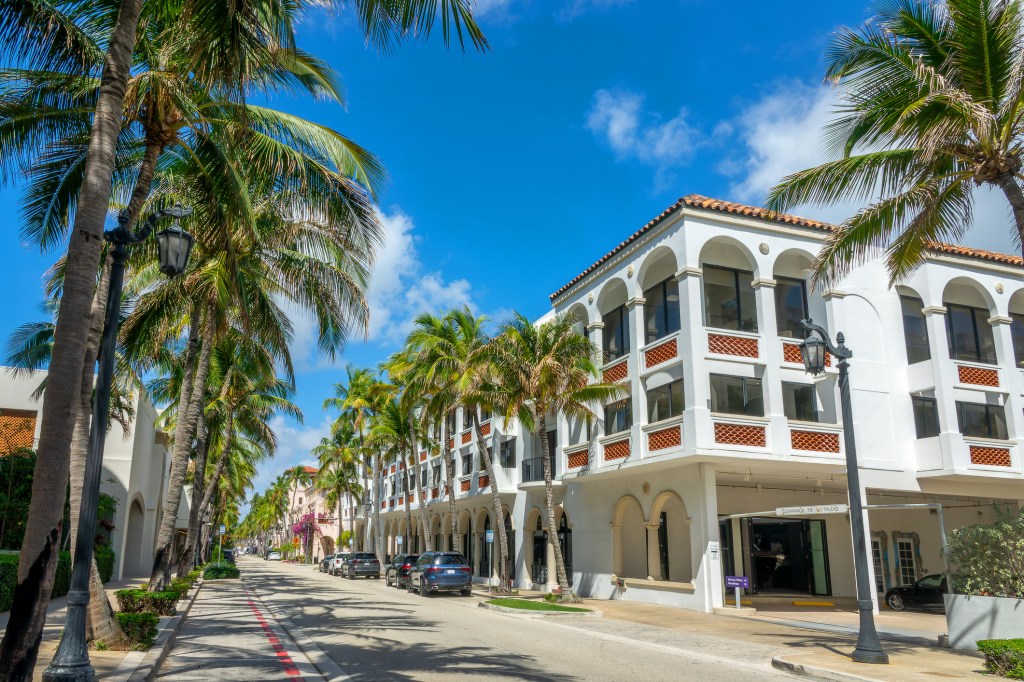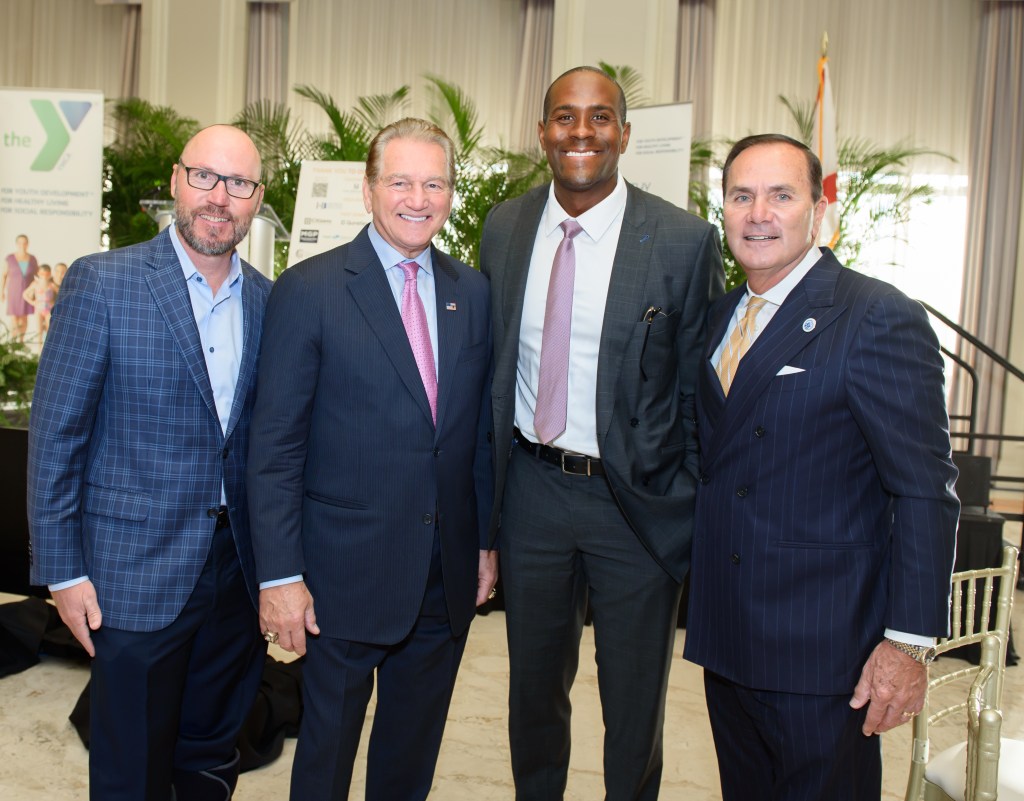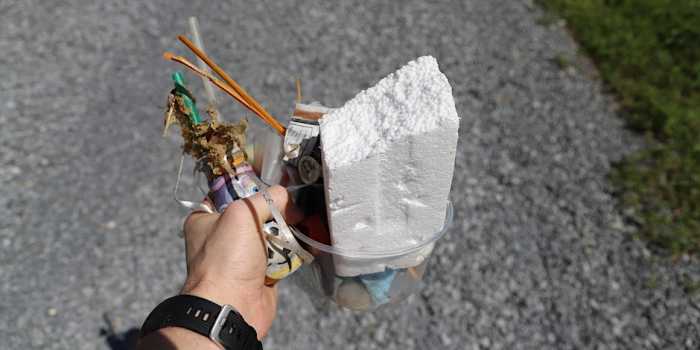Summer Ride: Adventures with a British Sports Car in the Hamptons

When spring arrives, as it just did, it immediately sends me out the kitchen door of my house to the best thing I have ever bought in my life. It sits in the garage. It’s a little red sports car that I paid a man named Charlie Brown $800 for some years ago. It sits there all winter, shivering and hibernating in the dark waiting for its time. That time, as it is every year, is now. The garage door goes up. And there it is, bouncing back and forth on its little tires, just waiting to get the show on the road.
I remember the day I bought this car. It was on a sunny spring day just like this one, and it was in the gravel parking lot of a small nightspot in Hampton Bays called Charlie Brown’s (now called C.B.’s).
Its top was down. The owner of this cute little English sports car, the owner of this night spot, was leaning on its fender. Behind him, on the windshield, was a big sign reading, FOR SALE 1959 TRIUMPH TR3.
The year was 1967. It was 8 years old. I bought it. And when Charlie Brown took out the registration, I was surprised to see he really was a guy named Charlie Brown. I had been in that place many times. And I thought it was just named after the Peanuts character Charlie Brown. Lots of bars bore names like that in those days. But this was a different Charlie Brown, from Patchogue.
Many friends, male friends I have today, owned a Triumph TR3 or one of the other big British sports cars back then. In the late 1950s, they were available cheap. World War II was over. American G.I.s, stationed in England, had brought them home on boats. Their contemporaries were Austin-Healeys, MGs, Morgans and Jaguars.
“I owned one of those,” I am often told. “But I sold it.”
There were circumstances, they say. Divorce. Kids. A need for cash. Growing up. A belief that these sports cars were dangerous. (They are.)
There are other friends I have today, mostly male, mostly rich, who own old English sports cars. They have them restored. They keep them in air-conditioned garages that are attended 24/7. Some of these garages offer video services. You can have a live video feed of your car sitting in its garage sent off to your computer in your Manhattan office. It’s what others do about babies. They do this about cars.
They show me their sports cars, all shined up. They say they paid $22,000 for it, and now it’s worth $30,000 two years later. And they want to know what dealer sold me mine and what did I pay for it. “I bought it from a guy who owns a bar in Hampton Bays for $800,” I say. “That was 46 years ago.”
They do not skip a beat. “Care to sell it?” they ask.
Out in the garage, I walk once around the car. It is bright red, sits low to the ground and has a metal frame to which you can attach a canvas hood if it starts raining. In the front grille, there is a hole. In the trunk, if you clear out the mouse nests, there is a metal crank you can stick into the hole. It is possible to crank the car to start it, though I have never done it.

I lift the hood of my Triumph TR3, check the radiator water level, the oil level, the brake fluid level, spray some starter fluid into the dual air cleaners, hook up a portable battery charger, go around to open the driver’s door to sit behind the wheel in the bucket seat, turn the key in the ignition to “on,” pull out the choke, pump the gas pedal 10 times to prime it and then carefully press the starter button. The car coughs and sputs. We stop and do it again. Now it catches, and roars, and I keep the gas pedal down halfway to keep it roaring, to keep the engine getting used to this wonderful spring day. Blue smoke comes out the exhaust pipe at the back briefly as it blows the winter’s idleness from its long sleep.
After five minutes of running the engine, the needle in the heat gauge on the dashboard begins to rise, and I let out the clutch and put this antique into reverse. If when I slowly release the clutch there are no further complaints from the car, I know it is time to take her out onto the road. I back down the driveway to the street and off we go, a coltish thoroughbred from an era a half-century ago, accelerating into the traffic for a parade through town with its top down. Summer is here.
The top speed of a Triumph TR3 is supposed to be about 110 miles an hour. The car is powered by a four-cylinder engine originally designed five years earlier for tractors in England, but put into this car because the company had no time, if it was going to catch the sports-car craze, to design a new engine.
Late one night in 1985, I had an occasion to see how fast it would go. I’d had a big fight with my wife at the time, and she ran out to her car—a little black Chevette not much bigger than the TR3—and she drove off in anger. She often did this when angry. Usually it wouldn’t be until the next afternoon that she’d come back, all calmed down and acting as if nothing had happened. I never before had known anyone who did this. And this time, I wanted none of it. I ran out, jumped into the TR3 and took off after her.
It was 3 a.m. I chased her down Main Street in East Hampton at around 70, along Hedges Lane in Sagaponack, through Main Street in Bridgehampton and off to Southampton and the Sunrise Highway. When she hit the six-lane highway there, I was right behind her. I’d stuck to her the whole way.
But then she opened up that Chevette. They don’t make Chevettes today, and you don’t see them around much. They were modest cars with not much power. I was sure I would be able to catch her.
On the Sunrise, she took it up to 85 and I stuck to her, she took it to 90 and I was still there, she was at 95 and then 100 and 105 and way down the road ahead of me and pulling so far ahead I could no longer see her. She was gone.
I looked at the speedometer of the TR3. It read 88 miles an hour. This British sports car was wound out, as fast as she could go. But I forgave her. That little TR3 was, at that point, a 17-year-old automobile.
I patted her on the dashboard.
“You did your best, girl,” I told her.
My wife came back the next day, as she usually did. We’d learned something. Her car was faster than my car.
As the years went by, I used it less and less. Now I just use it for select occasions, because of how hard it is to get parts for it. I still remember when the driver’s seat broke.
There were no more Triumph car dealers when this happened in 1991. So I took it to a car repair place. This seat, built on a metal frame, had a hinge inside the padding. You could pull the back forward to let up to two people sit ridiculously on a 10” plank of wood that was the back seat. But now the hinge had given way. I’d had to prop up the seat back, something I did with a sailboat life jacket wedged between the back of the seat and the bench.
“It just needs a new hinge,” I told J.J., the owner.
J.J. opened part of the leather at the seam and looked inside. “There’s a metal frame in there. It’s probably all rusted through.”
“See what you can do,” I said, and left it with him. Two days later he called to tell me it was hopeless. It was all rusted out.
I told him I had made some inquiries and there were no new TR3 seats being made anywhere. He’d have to repair this one.
“I have a couple of Thunderbird seats I could put in there,” he said.
“I’m going to find TR3 seats,” I said. “I’ll call you back.”
It became a quest. I asked junkyards. I asked old car clubs. I even asked Moss Motors in California, who made parts for old sports cars.
“We don’t have any and they don’t make any,” they told me. But I persisted.
“Surely, in all these years, there have been garages you’ve dealt with that repair TR3s. Don’t you ever remember anybody mentioning they had the two bucket seats?”
“Now that you mention it, I do,” the man said. “There’s a garage in Charlottesville, Virginia, where a mechanic works who had an Austin-Healey that needed seats. We sent him TR3 seats by mistake. He said someday he’d need them, so he kept them. I bet he still has them.”
I was given this man’s name. And so I called the garage. Or rather I called every car repair garage in Charlottesville until I located him.
“He used to work here,” I was told. “But he doesn’t anymore. I think he works as a night orderly in a hospital in Dayton, Ohio.”
Soon I tracked him down, and yes, he still had the seats. And yes, he would sell them.
“How much you want for them?” I asked.
He thought about it. “I guess you’d pay whatever I asked, since you can’t get any anywhere else. I wouldn’t take less than $50 for the both of them. Final offer.”
“Do you live near the airport?” I asked him.
“The Dayton Airport?”
“Yes.”
“About 20 minutes away.”
“Just so happens, I have business in Dayton on Friday. If you could bring them down to the airport—I’ll call you back with the flight information—I’ll buy them from you for the $50. Just wrap them in plastic. I’ll take them home as luggage.”
“Okay.”
And so that is what we did. I sit in them today.
Late one night in 2005, I pulled into the parking lot of the 7-Eleven in Sag Harbor and found just one parking space available. I pulled in and discovered, to my astonishment, that I was right next to another bright red 1959 TR3, exactly like mine. The only way to tell them apart was that the other one had a luggage rack on the trunk. I waited. Soon a man of about 35 strolled out with a cup of coffee and came to a sudden stop when he saw my car next to his. We talked for about 15 minutes about our cars, he gave me his contact information—he lived in Noyac—I gave him mine, and we never saw each other again.
Of all the sports cars made by the British in the post-war era, the TR3, as it has turned out, was the most popular. Tens of thousands of them were sold. The Jags and Austin-Healeys and Morgans and MGs sold far less and so today are very rare. If you can find one, you’ll pay $20,000 or so for it. The Triumph like mine, however, is not so valuable. You can pick one up for probably half that. But not mine.
Early on Sunday mornings this summer, you might find me at Marty’s Deli in Springs on a bagels and lox run. Lots of the other sports car owners show up then. But I’m probably the only one who’s owned my car since Lyndon Johnson was heating up the Vietnam War.










